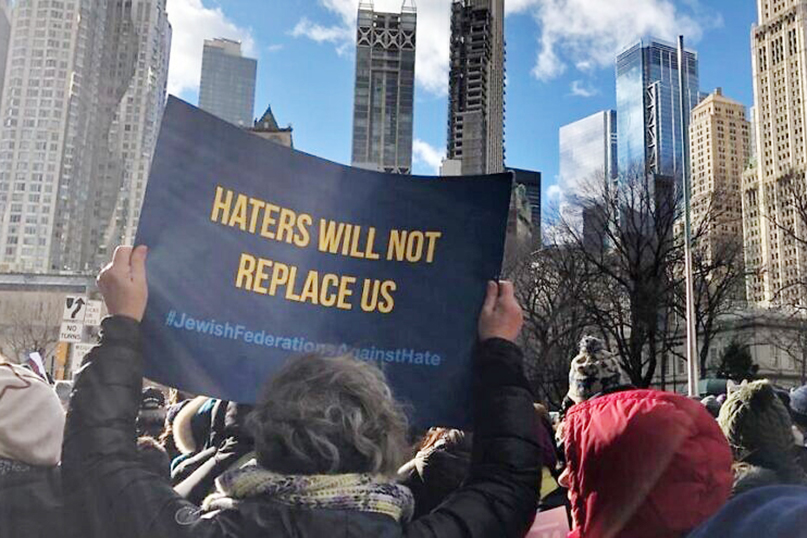
CT numbers are down, but remain at all time high
HAMDEN – The number of antisemitic incidents in the United States in 2019 were the most in at least four decades, according to the annual ADL Audit of Antisemitic Incidents, released on Monday, May 18, by the Anti-Defamation League.
Across the United States, ADL counted a total of 2,107 antisemitic incidents in 2019, the highest total ever recorded by ADL, and representing a 12 percent increase from the 1,879 incidents recorded in 2018, with a disturbing 56 percent increase in assaults.
There were incidents reported in every state except Alaska and Hawaii. The audit found there were, on average, as many as six antisemitic incidents in the U.S. for each day in the calendar year – the highest level of antisemitic activity ever recorded by ADL.
Connecticut, however, experienced a five percent decrease in antisemitic incidents over last year. The 2019 audit recorded 37 antisemitic incidents statewide in Connecticut, down from 39 reported incidents in the previous year and an all time high of 49 in 2017.
However, the 2019 numbers still represent a 30 percent increase over the last five years – as in 2015, ADL reported 26 antisemitic incidents in Connecticut.
“While we are encouraged that the overall number of antisemitic incidents in Connecticut fell slightly in 2019, these numbers still represent a historic high water mark for hate in our state,” said Steve Ginsburg, regional director of ADLConnecticut. “Over the last five years, Connecticut has experienced a significant increase in antisemitic incidents of harassment, vandalism, and/or assault.
“In 2020, we have already begun to see some disturbing trends emerging, as conspiracy theories and antisemitic language have permeated the political and public discussion surrounding COVID-19. We will continue to monitor and track these developments, while at the same time relying on our community members to report antisemitism they either experience or witness,” he added.
The ADL Audit includes both criminal and non-criminal acts of harassment and intimidation, including distribution of hate propaganda, threats, and slurs. The Audit classifies incidents into three categories: harassment, vandalism, and assault.
Nationally, the year included five fatalities directly linked to antisemitic violence and another 91 individuals targeted in 61 physical assaults – cases where individuals were physically targeted with violence accompanied by evidence of antisemitic animus. Antisemitic assaults increased 56 percent from 39 in 2018. Eleven of the 61 assaults were perpetrated with deadly weapons such as guns or knives. More than half of the assaults nationwide took place in the five boroughs of New York City, including 25 in Brooklyn alone.
Some 1,127 harassment incidents where recorded – cases where one or more Jews reported feeling harassed by the antisemitic language or actions. Acts of harassment increased by six percent from 1,066 in 2018.
A tally of 919 vandalism incidents took place – cases where property was damaged in a manner that harmed or intimidated Jews. Swastikas, which are generally interpreted as symbols of antisemitic hatred, were present in 746 of these incidents. Acts of antisemitic vandalism increased 19 percent from 774 the previous year.
The record number of incidents came as the Jewish community experienced antisemitic attacks in Poway, California; Jersey City, New Jersey; and Monsey, New York; in addition to the spree of violent assaults in Brooklyn, New York.
The ADL’s Center on Extremism identified 234 incidents targeting Jewish synagogues and community centers in 2019. This included the white-supremacist shooting at Chabad of Poway that resulted in the death of a 60-year-old worshipper and injured three others, including the rabbi.
“This was a year of unprecedented antisemitic activity – a time when many Jewish communities across the country had direct encounters with hate,” said ADL CEO and national director Jonathan Greenblatt. “This contributed to a rising climate of anxiety and fear in our communities. We are committed to fighting back against this rising tide of hate and will double down on our work with elected leaders, schools and communities to end the cycle of hatred.”
The ADL began tracking antisemitic incidents in 1979.
ADL’s Center on Extremism has gathered the complete 2019 data, as well as data from the previous two years, on ADL’s H.E.A.T. Map, an interactive online tool that allows users to geographically chart antisemitic incidents and events nationally and regionally.
The full 2019 ADL Audit of Antisemitic Incidents, can be found at https://www.adl.org/audit2019.
Main Photo: Participants at the “No Hate. No Fear.” rally in New York City on Jan. 5, 2020. (Credit: Rivka Segal)







 Southern New England Jewish Ledger
Southern New England Jewish Ledger














